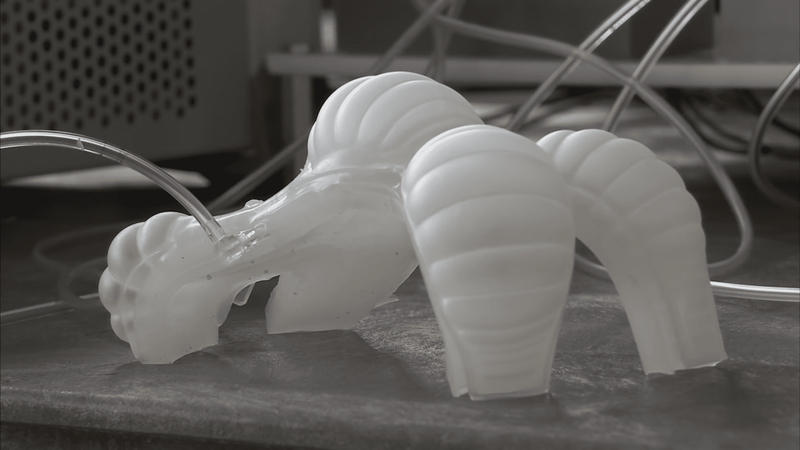Powering Soft Robotics: A Deeper Look at Soft Robotics Actuators
As the field of soft robotics continues to evolve, one of the most critical challenges researchers face is developing reliable and efficient power sources to drive these pliable machines.

Image source: NASA
This article was first published on
www.wevolver.comSoft robotics is a rapidly advancing field of robotics that involves the design and development of robots made from flexible and deformable materials. These robots, unlike their traditional rigid counterparts, have the ability to adapt to their environment, navigate complex and dynamic spaces, and interact safely with humans. Soft robots can be made from materials such as silicone, rubber, and other flexible polymers, and they can be made to resemble a wide range of shapes and structures.
In this article, we list out and explain in detail the different types of actuators used in soft robotics, including pneumatic, hydraulic, shape memory alloys, electro-active polymers, and magnetic fields. We also explore some applications of soft robotics enabled by them.
Introduction
Since the early days of robotics, the focus has been on rigid and inflexible machines capable of performing specific tasks with high speed, high accuracy, and high repeatability. However, the limitations of traditional robotics eventually became apparent in specific fields, such as medicine, manufacturing, and disaster response, where safety and flexibility were critical.
Further research in the domain led to the creation of soft grippers and other soft components that could let the robots interact with their environment in a much better way.
With the rise in popularity of biomimetics, the study of nature that inspires the design and development of new technologies, researchers have increasingly drawn inspiration from the behavior of biological entities to come up with creative ideas for the development of new and innovative robotic systems.
Suggested reading: Biomimetics: The Science of Robo-Animals
Advancements in material science and fabrication techniques, such as 3D printing, enabled the development of more complex soft robots that could be applied in various areas like biomedical devices, wearables, and disaster response.[1]
In the early 2010s, Prof. George Whitesides from Harvard University coined the term “soft robotics”.[2] IEEE Robotics and Automation Society established a new technical committee for soft robotics to promote research in the domain, and since then, the field has continued to evolve.[3]
Types of Actuators Powering Soft Robots
Soft robots need power sources to drive the actuation of their moving parts. Actuation is the process of generating movement in a robot, and it is necessary for soft robots to be able to move and interact with their environment. Here are the different types of actuators powering soft robotics:
Pneumatic and Hydraulic actuators
Just as electric motors require a power source, such as a battery or an external power supply, to drive the robot's movement, hydraulic and pneumatic systems require a source of pressurized fluid, such as air or water.
Pneumatic actuators use compressed air to generate force and motion. They are often made of flexible materials such as rubber or silicone and can be shaped to fit a variety of applications. Pneumatic artificial muscle made of a flexible tube can expand when pressurized and produce a contracting force when depressurized.
Hydraulic actuators, on the other hand, use a liquid such as water or oil to generate force. They can produce higher forces than pneumatic actuators and are often used in industrial automation applications. In soft robotics, hydraulic actuators are made of flexible materials.
While pneumatic actuators are lightweight and easy to control, they may not be as powerful as hydraulic actuators to drive a soft robot. Hydraulic actuators generate more force but require additional components, such as pumps and reservoirs, to function, which can add significant complexity to the design.
Pneumatic and Hydraulic actuators may also incorporate sensors and feedback mechanisms to enable precise control. Ultimately, the choice of the actuator depends on the specific requirements of the soft robot being developed.
Shape-memory alloys
Shape-memory alloys (SMA) are unique actuators that change shape when exposed to heat. This method also requires a power source, such as a battery or an external power supply, to generate the electric current for heating up the alloy.
SMAs can be bent or deformed into a particular shape, and when they are heated, they will return to their original shape, generating a mechanical force. This property makes them useful for soft robotic systems that require high force and precision, such as those used in biomedical devices and prosthetics.
Some commonly used SMAs are Nitinol (Nickel-Titanium alloy), Copper-Aluminum-Nickel alloys, Iron-Manganese-Silicon alloys, Copper-zinc-aluminum alloys, etc. Overall, SMAs have a number of useful properties, including less weight, flexibility, and the ability to generate high forces, making them a promising power source for developing soft robotic devices.
Electro-active polymer actuators
Electro-active polymer (EAP) actuators use an applied electric field to generate mechanical deformation. EAPs are a promising technology for use in soft robotics, as they offer several advantages over other types of actuators.
The key advantages of EAP actuators are their softness and flexibility. EAPs can be fabricated into a variety of shapes and sizes, making them well-suited for use in soft robots. Additionally, EAPs have the potential to be more lightweight and energy-efficient than traditional actuators, which can be crucial in applications where weight and power consumption are critical.
There are several types of EAP actuators, including dielectric elastomer actuators (DEAs), ionic polymer-metal composites (IPMCs), and conductive polymers. Each of these types of EAP actuators works by a different mechanism, but all of them involve the use of an applied electric field to generate mechanical deformation.
DEAs, for example, are made of a thin layer of a soft, electrically insulating polymer sandwiched between two layers of compliant electrodes. When an electric field is applied to the electrodes, it causes the polymer to deform, generating a change in shape or volume. This deformation can be used to drive the movement of a soft robot.
IPMCs are made of a thin layer of an ion-containing polymer sandwiched between two layers of metal electrodes. When an electric field is applied, the ions in the polymer move towards one of the electrodes, causing the polymer to bend. This bending can be used to generate movement in a soft robot.
Conductive polymers are a third type of EAP actuator that use the conductivity of the polymer to generate mechanical deformation. When an electric field is applied to a conductive polymer, it causes the polymer to expand or contract, depending on the strength and the direction of the field. This deformation can be used to drive the movement of a soft robot.
EAP actuators offer a promising avenue for actuation in soft robotics; however, there are still several challenges that need to be addressed to fully realize their potential in soft robotics, such as improving their durability and scalability.
Magnetic actuators
Magnetic actuators, as the name suggests, are actuators that use magnetic fields to generate movement. They consist of a magnet embedded in a flexible, elastomeric material. When a magnetic field is applied to the magnet, it causes the elastomer to deform, which drives the movement of a soft robot.
One of the advantages of magnetic actuators is that they are relatively simple and inexpensive to fabricate. They also offer a high degree of precision and control, which can be important in certain applications.
In soft gripper applications, magnetic actuators are used to generate the force needed to grasp and manipulate objects. By adjusting the strength and direction of the magnetic field, the grip force of the gripper can be finely tuned to the requirements of the task. In soft manipulator applications, magnetic actuators are used to drive the movement of the manipulator, allowing it to perform tasks such as grasping and releasing objects. In sensor applications, magnetic actuators are used as the sensing element, allowing the robot to detect and respond to changes in its environment.
One of the challenges of using magnetic actuators in soft robotics is the need for a strong and consistent magnetic field, which can be difficult to achieve. Additionally, the design of the magnetic actuator can affect its performance, and optimizing the design can require a significant amount of time and resources.
Applications of Soft Robots
Soft robotics is an emerging field that has the potential to revolutionize a wide range of industries. Here are some of the applications of soft robotics:
Healthcare: Soft robots can potentially transform healthcare by enabling new forms of minimally invasive surgeries. The technology can also be used to build exosuits that help people with disabilities regain mobility. When used for making prosthetics, soft components can provide a more natural and comfortable fit for amputees.
Manufacturing: Soft robots are well-suited for manufacturing applications that require delicate handling of objects. They can also be used in assembly line operations to handle fragile components or to package products more efficiently and gently.
Survey and exploration: Soft robots can make their way through challenging environments such as underground mines, deep-sea environments, and space. Their softness and flexibility enables them to adapt to different obstacles and harsh environments.
Agriculture: Soft robots can be used in agriculture to perform tasks such as planting, harvesting, and weeding. They can navigate through the fields without damaging crops. When used in conjunction with sensors and machine learning algorithms, these robots can prove to be a great help.
Search and Rescue: Soft robots can be used in search and rescue operations to locate and extract people from collapsed buildings or search for survivors in areas inaccessible to traditional search and rescue equipment.
Entertainment: Soft robots can be used in theme parks, animatronics, and other interactive means of entertainment to provide a more lifelike and engaging experience for users. They can also be possibly used to create new forms of entertainment.
Education: Soft robots can also be used in educational settings to teach students about robotics and engineering. The teachers can demonstrate concepts such as motion, force, and control and inspire students to pursue careers in science and technology.
These are just a few of the many applications of soft robotics. As research in this field continues to advance, we will likely see many new and exciting applications in the future.
Conclusion
The development of advanced and sustainable power sources is key to unlocking the full potential of soft robotics and enabling these innovative machines to change the way robots interact with their environments.
About the sponsor: Mouser Electronics
Mouser Electronics is a worldwide leading authorized distributor of semiconductors and electronic components for over 1,200 manufacturer brands. They specialize in the rapid introduction of new products and technologies for design engineers and buyers. Their extensive product offering includes semiconductors, interconnects, passives, and electromechanical components.
References
[1] Wallin, T.J., Pikul, J. & Shepherd, R.F. 3D printing of soft robotic systems. Nat Rev Mater 3, 84–100 (2018). https://doi.org/10.1038/s41578-018-0002-2
[2] Carl Vause, ‘This robot has soft hands. It could be the future of sustainable production’, World Economic Forum, 21 June 2018, [Online], Available from: https://www.weforum.org/agenda/2018/06/robot-soft-hands-sustainable-production-soft-robotics/
[3] IEEE Technical Committee for Soft Robotics, [Online], Available from https://www.ieee-ras.org/soft-robotics
About Mouser Electronics
Mouser Electronics is a worldwide leading authorized distributor of semiconductors and electronic components for over 1200 industry-leading manufacturers. We specialize in the rapid introduction of...
202 Posts

